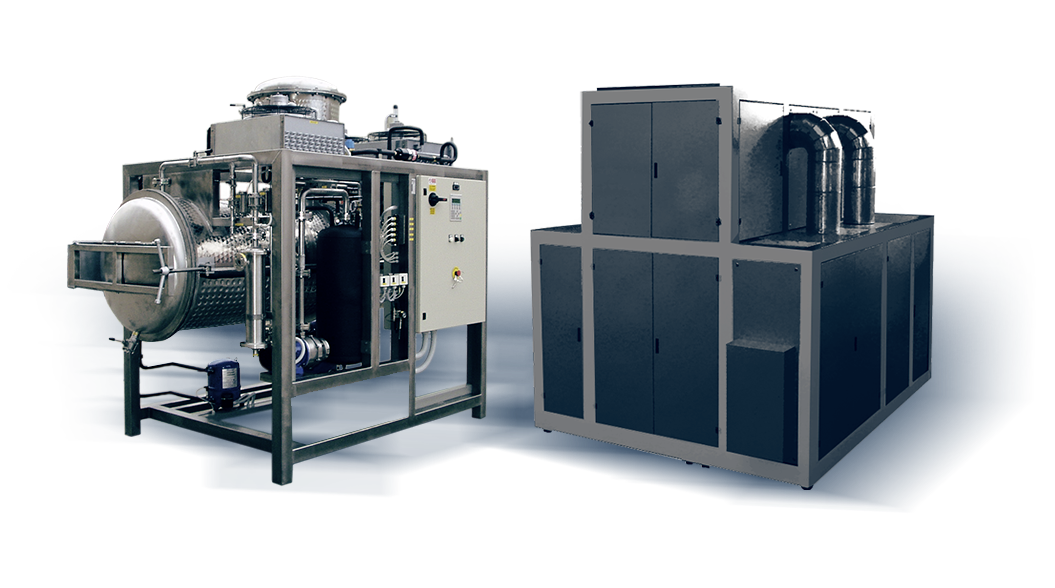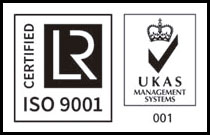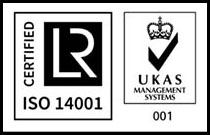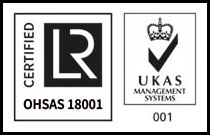CONTENTS
1
PROPERTIES OF TRITIUM
Tritium is a hydrogen isotope. It is a radioactive isotope that emits beta (β) radiation in its disintegration, according to the following reaction:
3H3He + β– + ν
This is important since it only emits beta particles and not gamma radiation, enabling the shielding of tritium-based radiation using simpler methods (methacrylate, high density plastic). Although tritium is a pure emitter, it only emits β particles with a maximum of 18 keV energy.
The increase in concentrations in the environment is problematic, owing to the ease with which it is incorporated into the DNA and RNA molecules of organisms and its ability to supplant protium in biological solutions, mainly aqueous ones. Its capacity for exchange with the hydrogen in water or the hydrogen in the hydroxyl group makes it separation problematic and difficult.
This produces aqueous solutions where the tritium replaces the conventional hydrogen isotope and generates difficult-to-treat tritrated solutions. The operational effluents at nuclear power plants contain high concentrations of tritium in addition to the isotopes typical of neutron and fission activation. This treatment of operation effluents is successful in resin treatment for isotopes, but does not allow tritium to be removed from the discharge effluents.
That is why the regulations in different countries establish permitted discharge activities for tritium. The aim of this article to is present an area of research in which cellulose filament structures present a certain ability to adsorb tritium. NUCLEANTECH is working on the implementation of these materials in tritiated wastewater treatment.
Different forms of separation have been proposed and are amply set forth in the literature.
2
TRITIUM-GENERATING PROCESSES IN A PWR REACTOR
Tritium can be found in nature, albeit in very low proportions. Specifically, it is produced in the ionosphere and by cosmic radiation, according to the following reaction:
But tritium is basically man-made. It is produced in human activities, especially at nuclear reactors. Of note in this regard are CANDU reactors used in Canada. The main feature of these reactors is the use of heavy water as a moderator and natural uranium as fuel. Neutron capture by deuterium leads to tritium. This procedure generates between 1 and 2 Kg/GWt per year.
The other source in the tritium-generating nuclear industry are PWR reactors. These reactors, widely implemented across Europe, produce tritium by coolant (water) neutron activation and a series of capture and fission reactions that occur in the core of the reactor, and which are set out below.
There are three ways to produce tritium in a PWR nuclear reactor:
1.- The use of certain chemical products in the primary system coolant, such as H3BO3 boric acid as a neutron moderator
and LiOH to correct the coolant pH. The Li-6 isotope is typically used. Rising lithium prices make it likely that KOH will soon be used as a pH adjustment element. The reaction is as follows:
2.- Deuterium capture reactions with the neutrons produced in fission reactions.
3.-Ternary fission reactions produced by 92U235 and 94Pu239 in the following form lead to the corresponding fission fragments:
| Sources of tritium | Global activity contribution (%) |
| Ternary fission | 22 |
| B10 (n,2α) H3 | 57 |
| Li7(n,nα) H3 + Li6(n,α) H3 | 20,6 |
| H2(n,ϒ) H3 | 0,4 |
Contribution of tritium sources to global activity in a PWR reactor
Source; Preliminary Safety Report of Sizewell B, Nuclear Electric.
Annual tritium production at a standard PWR reactor is appraised at 0.4-0.9 TBq/Mwe-year. The tritium formed in ternary fission reactions can migrate towards the coolant through microcracks. In a PWR reactor, tritium production in accordance with generated power can be expressed according to the following table:
| Electricity production (TWh) | H3 activity in wastewater (TBq) | Corrosion and fission product activity in wastewater (GBq) | H3 specific activity (TBq/TWh) | Corrosion and fission product-specific activity(GBq/TWh) |
| 12585 | 20.1 | 0.183 | 1.60 | 0.015 |
| 12132 | 18.3 | 0.314 | 1.51 | 0.026 |
| 12250 | 19.3 | 0.1 | 1.58 | 0.008 |
| 12627 | 18.6 | 0.412 | 1.47 | 0.033 |
| 12997 | 15.6 | 0.374 | 1.20 | 0.029 |
| 12230 | 14.5 | 0.170 | 1.19 | 0.014 |
This table shows the importance of tritium production and its contribution to wastewater activity (also gas emissions).
3
PRESENCE OF TRITIUM IN OPERATIONAL WASTEWATER
The primary system coolant in a PWR reactor extracts the heat from the reactor core and transfers it to a secondary system to generate an electric current via the corresponding generators.
This coolant incorporates corrosion elements in its solution (60Co; 54Mn; 58Co; 95Nb). It also incorporates fission isotopes (137Cs;131I; 134Cs;90Sr) and, obviously, tritium as the main isotope replacement for hydrogen in water.
This tritium activity is outlined on the table below, where we can see the importance of its activity. In terms of radioactivity, tritium is the dominant radionuclide in liquid emissions at nuclear power plants with PWR reactors.
| Specific wastewater activity from a reactor coolant | ||
| Isotope | Half-life | Specific activity (Bq/m3) |
| Cr-51 | 27.8d | 1.2E-6 |
| Mn-54 | 303d | 2.5E-7 |
| Fe-59 | 45d | 2.8E-8 |
| Co-58 | 71d | 4.1E-6 |
| Co-60 | 5.2a | 1.1E-6 |
| Zr-95 | 65d | 1.3E-8 |
| Nb-95 | 35d | 6.3E-8 |
| I-131 | 8d | 4.1E-7 |
| Cs-134 | 2a | 6.3E-7 |
| Cs-137 | 30a | 8.9E-7 |
| Sr-89 | 52d | 8.9E-9 |
| Sr-90 | 28a | 1.4E-9 |
| Xe-133 | 5.2d | 4.4E-7 |
| H-3 | 12.3a | 1.0E-3 |
4
DIFFICULTY IN TREATING TRITIUM
But treating tritium in a liquid medium is extremely difficult. In essence it involves separating water from “water”, i.e., conventional water from tritiated water. The boiling point of regular water and tritiated water is very similar.
This makes the distillation system of separation unacceptable, although attempts at cryogenic distillation are afoot. Specifically, the cryogenic distillation of hydrogen isotopes.
The cost is very expensive. There are also elements that absorb tritium as a hydride, such as uranium. Adsorption technologies using metal alloys are being developed in this area.
But there is no effective treatment to separate tritium from wastewater, so activity involving wastewater is high even when separating isotopes originating in nuclear operations. On this point we must remember the importance of separating these isotopes, since most are sources of gamma emissions, while tritium is not.
There are currently different proposals to reduce tritium production in a PWR reactor:
a.- Replace LiOH with KOH as the coolant pH regulator.
b.-Reduce the H3BO3 concentration.
When the tritium has been formed and the tritiated water produced, there is a series of proposals to separate the tritium. Some of the processes studied are detailed below:
a.- Hydride formation
Gas hydrogen, and therefore T2, react at high temperature with transition metals forming hydrides: scandium, yttrium, lanthanum, actinides, and especially the titanium and vanadium group elements.
The most efficient way to capture hydrogen to form hydrides is with uranium, but for reasons related to uranium use, the ZrCo alloy is used reversibly as follows:
Adsorption: 2ZrCo + 3T2 2ZrCoT3 + Q
Desorption: 2ZrCoT3 + Q 2 ZrCo + 3T2
The problems with this compound are its lack of stability and thermal decomposition, as follows:
2ZrCoT3 + Q ZrCo2 + ZrX2 + + 2X2
The use of hydrides offers a possibility of containing the T2. There are operational processes developed by Professor T. Motyka for the confinement of tritium (T2) with hydrides.
b.-The company Molecular Separations Inc. (MSI) has developed a patent for a bed of particles that selectively charges tritiated water as hydration water at close to ambient temperatures.
The tests were performed with a standard mixture of 126 μCi tritium/litre of water. Reductions to 25 μCi tritium/litre of water were shown using 2 x 2 m columns in series.
Using wastewater samples from Hanford, a reduction from 0.3 μCi to 0.07 μCi tritium/litre of water was achieved.
The tritium absorbed by the beds can be released with a moderate increase in temperature and the beds can be re-used. A mobile bed process has been proposed to treat representative amounts of wastewater.
It has also been shown that the separation system reduces tritium concentrations in cooling water to levels that allow its re-use (Technical University of Brno, Department of Thermal and Nuclear Power Plant).
c.- Studies related to tritium adsorption and treatment of tritiated liquid effluents have been carried out for a few years at the Belgian Centre for Nuclear Research, SCK/CEN. Initially, the studies focused on the removal of tritium from gaseous effluents originating in reprocessing procedures.
If tritium can be released from spent fuel before any aqueous operation, the most practical collection method is adsorption on molecular sieves, after an isotopic solution with hydrogen and subsequent complete transformation to tritiated water. SCK/CEN constructed an adsorption unit by oxidation of 15 m3/h with a closed regeneration system and a decontamination factor of 1000 in the total concentrations of tritiated hydrogen, and a water inlet up to 1000 parts per million per unit volume.
SCK/CEN is developing an isotope separation process called ELEX based on combining water electrolysis and tritium exchange between hydrogen and water, with a hydrophobic catalyst promoting the exchange. For electrolysis under normal conditions, an elementary tritium separation factor of 11.6 was obtained with a standard deviation of 6 %.
Regarding exchange capacity, a hydrophobic catalyst was developed that yields an overall exchange rate constant of 9 mol/s.m3 in a countercurrent drip bed reactor for flows used at atmospheric pressure and 20 °C. This pilot plant consists of two essential parts: an 80 kW water electrolyser and a 10 cm diameter drip bed column. The tritiated water feed rate is 5 L/h, which contains a tritiated aqueous phase of 3.7 GBq/L of tritium activity.
d.- Using the multiple bipolar electrolytic separation of hydrogen isotopes by Pd/Ag electrodes (25 % Pd), the possibility of separating tritium and tritiated species from different types of effluents was demonstrated.
Bipolar processes were achieved experimentally by individual cascade cells arranged in series, in which each bipolar electrode had the same area as the others. The factors measured for multibipolar H-D separation were close to the values measured in single-stage cell measurements; for the H-T separation, the leakage between stages reduced the measured separation factor.
However, in both cases a separation of sufficient magnitude was achieved to show the viability of a real application in the tritium extraction of large volume systems with a high current density.
e.- Cryogenic distillation. Required in this option is a pre-distillation step, an electrolytic process that transforms the tritiated water into H2, T2 gas molecules and deuterium, if applicable.
These gases can be stored in titanium beds. This distillation process is carried out at 24 K and is one of the methods tested for enrichment and separation of hydrogen isotopes on an industrial scale with a good separation factor.
The disadvantages of this type of plant are the high energy cost to maintain the extreme cryogenic temperatures, as well as the high content of tritium inventory. (J. M. Miller et al.)
5
CELLULOSE-BASED DEUTERIUM ADSORPTION
Cellulose is the most abundant renewable organic material produced in the biosphere, having an annual production estimated to be over 7.5 × 1010 tonnes. Cellulose is a fibrous, tough, water-insoluble substance that plays an essential role in maintaining the structure of plant cell walls.
Cellulose is a homopolysaccharide composed exclusively of glucose molecules. The cellulose polymer is rigid when dry, insoluble in water and contains thousands of units of β-Glucose. (Habibi et al.).
The first report on deuteration experiments with cellulose samples dates back to the early 1930s, when Bonhoeffer investigated the reaction of heavy water and cellulose. His experiments did not address the understanding of the polymeric structure of cellulose, determined by Staudinger some years before in 1920.
On the basis of viscosity measurements, Staudinger found the supramolecular structure of cellulose to be a linear arrangement of the polymeric molecule. The crystalline nature of cellulose was investigated by means of electron diffraction and X-ray scattering. These methods prompted discussions on the reactivity of crystalline and amorphous domains contained in the cellulose supramolecular structure.
One of the first attempts to measure reactivity differences was made by Goldfinger et al., who showed that there are two rate constants in the course of oxidation of various cellulose samples with periodate solutions. The rate constants differed significantly and the faster of these was determined to take place preferentially in the amorphous domains, whereas the second was related to the crystalline domains.
It has been known for some time that the hydroxyl groups (-OH) accessible from cellulose could reversibly become (-OD) when the cellulose samples were subjected to D20 in a liquid or vapour state. (Ponny et al.) This deuteration phenomenon can be monitored using Fourier-transform infrared spectroscopy (FTIR), one of the best techniques to measure the ease of hydrogen-deuterium exchange in the cellulose structure.
The neutron dispersion technique has also been used. It has been observed in mercerisation processes that the cellulose fibre submerged in sodium deuteroxide (NaOD) that registers diffraction diagrams with neutrons differs substantially from hydrogenated patterns. All studies verify that there is an effective replacement of part of the protium hydrogens for deuterium hydrogens. This association of deuterium with the cellulose structure preferably takes place with the cellulose amorphous phase. (Frilette et al.)
6
CELLULOSE STRUCTURE-BASED TRITIUM ADSORPTION
The company NUCLEANTECH has been developing different treatments in the field of adsorbents in recent years, with the aim of selectively minimising the presence of certain radioactive isotopes. Considering the ability to absorb deuterium in a cellulose structure, NUCLEANTECH proposed studying this adsorption capacity with tritium, leveraging cellulose filaments with a high amorphous structure content.
Theoretical Aspects
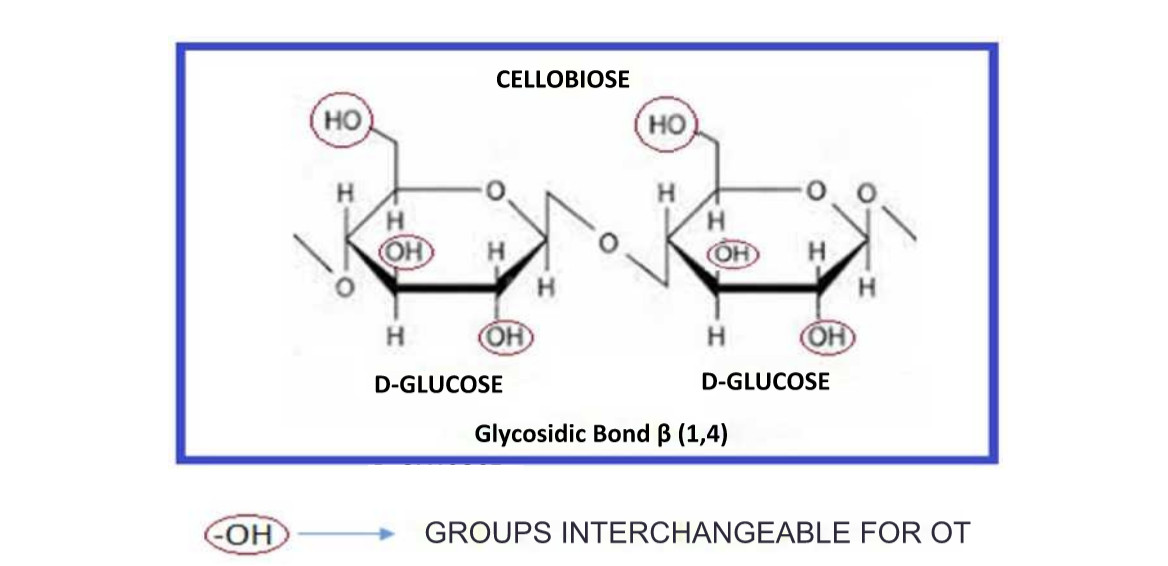
This capacity of these new materials is being tested in operation effluents from a PWR nuclear power plant. The preliminary results NUCLEANTECH has obtained on tritium adsorption can be represented in the chart below (Table 2):
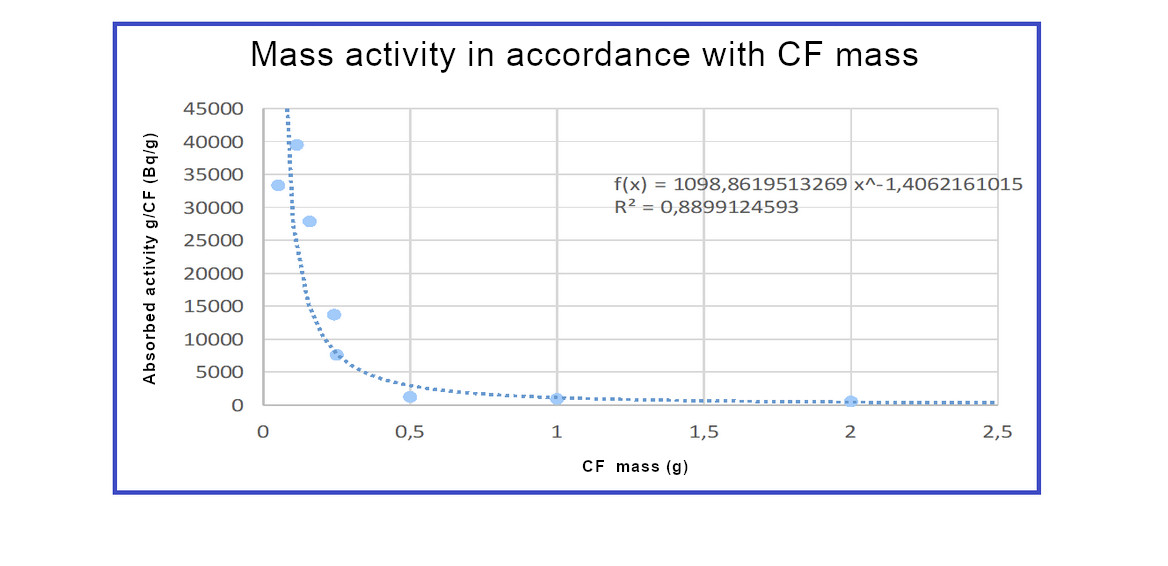
(Table 2)
These adsorbed 40000 Bq per cellulose gram, reported in the first experimental works conducted by NUCLEANTECH, refer exclusively to tritium. This property opens a field in effluent treatment with low tritium activity and the development of filters to treat tritium-contaminated gaseous effluents.
We will continue striving to treat increasingly active effluents. These results confirm tritium adsorption on cellulose filament structures, preferably amorphous in nature.
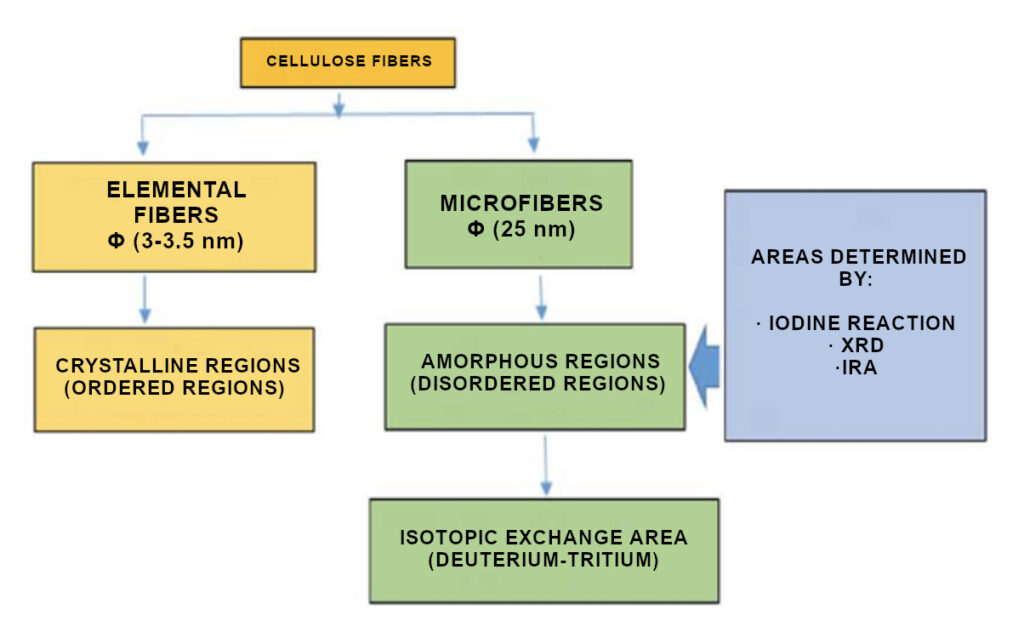
The basis for the experimental work we have been doing on effluents from an operational PRW reactor at NUCLEANTECH for the past year focuses on the adsorption capacity of particular cellulose filaments with respect to tritium (patent).
These cellulose fibres, duly treated using a patented chemical procedure, give rise to cellulose microfibres with extensive amorphous regions. These amorphous (noncrystalline) regions permit the exchange of cellulose hydroxyl groups for OT groups of tritiated water.
In this regard, we think the phenomenon of tritium absorption might be due to the effect of the enhanced stability of the bond produced by the tritium with the structure carbon. This would explain the stability of the C-T and O-T bond from the kinetic isotopic effect. This effect numerically justifies less zero-point energy and therefore greater bond stability.
| Diatomic molecule | μ (Reduced Mass) | Diatomic molecule | μ (Reduced Mass) |
| -OH | 0.941 | -CH | 0.92 |
| -OD | 1.77 | -CD | 1.71 |
| -OI | 2.52 | -CT | 2.4 |
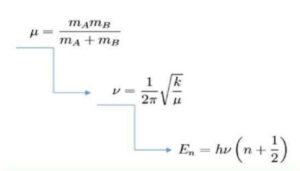
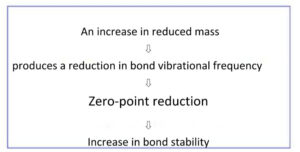
We are harnessing this theoretical development to work on adsorbing tritium with these cellulose filaments.
Lyophilisation, low humidity content and amorphous character are metrics we consider help shore up tritium adsorption. Effluents where tests have been run correspond to diluted solutions taken from the PWR nuclear reactor primary system. The solutions we have worked on had an average activity of 400 Bq/g in tritium and came from the original parent solution.
The cellulose was in contact with the solution for three hours and filtered using conventional means. Measurements were subsequently taken. The maximum adsorbed tritium value found in these experimental series was 4500 Bq for a cellulose concentration of 1 g/L of solution.
7
EXPERIMENTAL PROCEDURE
The optimal type of cellulose for adsorbing tritium was first established. It was ascertained as being cellulose filaments with an extensive amorphous structure.
This is optimal for tritium adsorption. The experiment in selecting cellulose types resulted in the following values:
| TRITIUM ADSORPTION (457Bq/g) | |||||
| Adsorbent (Filaments) | Adsorbent (g) | C Concentration (g/l) | Adsorbed Tritium Activity (Bq) | Bq ratio (adsorbed)/ adsorbent g. | % performance |
| S1 | 0.1571 | 1,57 | 6300 | 40101,8 | 13.78 |
| S2 | 0.226 | 2,26 | 100 | 442,47 | 0,2 |
| S3 | 0.3257 | 3,25 | 1100 | 2763,27 | 1,9 |
| T1 | 0,1155 | 1,15 | 400 | 3463,2 | 0,8 |
| T2 | 0,2109 | 2,10 | 2500 | 11853,95 | 5,4 |
| T3 | 0,3972 | 3,97 | 700 | 1762,33 | 1,5 |
Type S1 cellulose corresponds to cellulose filament structures. These structures are produced on the basis of the following patent: US9051684B2/en. These structures offer the best adsorption performance value: 13.78 %.
Different adsorption kinetics were performed with this cellulose type. In these kinetics, variable amounts of cellulose filaments were put into contact with around 100 g of solution of some 400 Bq/g in tritium, taken from the primary system of a PWR reactor.
The cellulose was weighed at the power plant lab and put in contact with 100 grams of solution of around 400 Bq/g of tritium for some 5 hours, by means of agitation. It was subsequently filtered and activity owing to the tritium was measured.
Different experimental series were carried out, delivering efficacies of between 4 % and 13 %. This variation in activity is due, we believe, to the problems with filtering such a small particle size. The most optimal kinetic series is as follows:
| TRITIUM ADSORPTION (415 Bq/g) | |||||
| Adsorbent (Filaments) CF1 | Adsorbent (g) | C Concentration (g/l) | Adsorbed Tritium Activity (Bq) | Bq ratio (adsorbed)/adsorbent g. | % performance |
| 1 | 0,051 | 0.5 | 1700 | 33333,33 | 4 |
| 2 | 0,114 | 1,14 | 4500 | 39473,7 | 11 |
| 3 | 0,158 | 1,58 | 4400 | 27848,1 | 11 |
| 4 | 0,241 | 2,41 | 3300 | 13693 | 8 |
| 5 | 0.5 | 5 | 600 | 1200 | 1,45 |
| 6 | 1 | 10 | 900 | 900 | 2,18 |
| 7 | 2 | 20 | 1100 | 550 | 2,66 |
The chart below shows the adsorption capacity of tritium Bq per gram of adsorbent, compared to adsorbent grams. We can see that better adsorption values are obtained for a range relatively low in cellulose concentration, around 1 g/L.
The results are presented on the table below (Table 3).
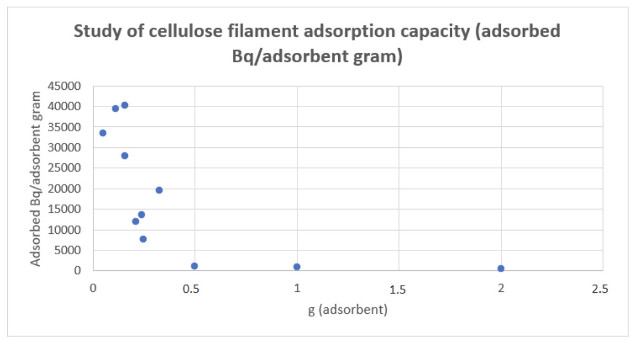
(Table 3)
If we assess adsorbed becquerels by grams of cellulose, we see that adsorption is higher at lower cellulose concentrations. This might be related to the filtering. The following table shows the adsorbed becquerels by cellulose mass (Table 4).
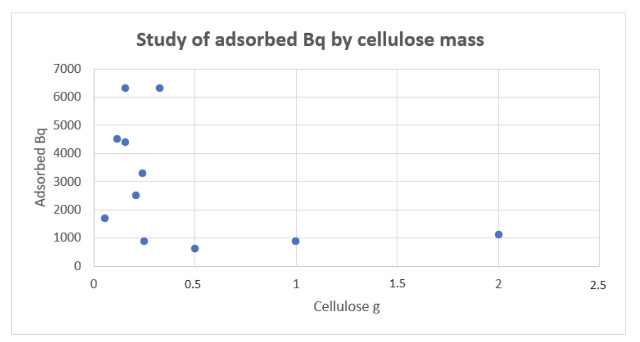
(Table 4)
The table below shows a relationship between cellulose concentration and the tritium adsorbed by it. Quantitative filter paper was used for filtering in all these cases. (Table 5).
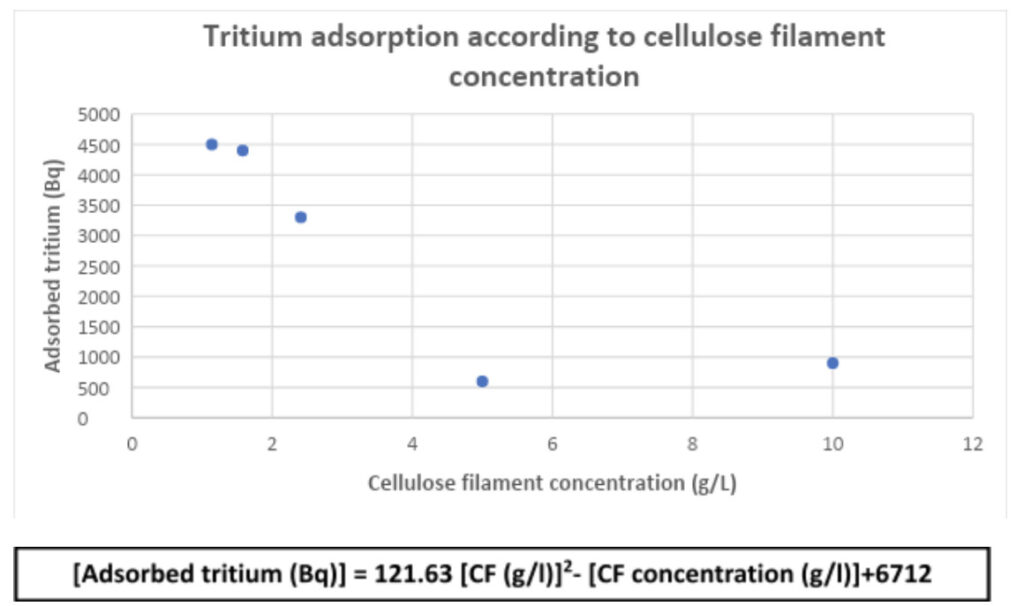
(Table 5)
The best value obtained at present is 4500 Bq for 0.1 gram of cellulose. This made it possible to reduce tritium activity from 415 Bq/g to 370 Bq/g; 11 %. We are working on the question of filtering and cellulose processing to optimise yields. We think they can be increased.
8
CONCLUSIONS
Nuclear operations with wastewater and flue gas involve working with isotopes generated by neutron activation, corrosion or fission. Whatever parent solution is used, it always includes a certain amount of tritium that complicates effluent treatment.
The ease with which tritium is incorporated into the water molecule makes it too hard to treat to reduce effluent activity. Different laboratory processes have been leveraged and a very few successfully employed at the industrial level (cryogenic distillation).
NUCLEANTECH is developing a wastewater tritium-capture process that involves tapping a property widely studied by the literature and which presents certain cellulose filament structures exchanging protium isotopes for deuterium ones.
The company has harnessed adsorption kinetics to bring diluted solutions (400 Bq/g) from a PWR nuclear reactor coolant into contact with cellulose filaments. The adsorption values oscillate between 11 and 14 %.
9
BIBLIOGRAPHY
Frilette VJ, Hanle J, Mark H (1948) Rate of exchange of cellulose with heavy water. J Am Chem Soc 70:1107–1113
Habibi Y, Lucia LA, Rojas OJ (2010) Cellulose nanocrystals: chemistry, self-assembly, and applications. Chem Rev 110:3479–3500
J.M.Miller, W.T.Shmayda, S.K.Sood, D.A.Spagnolo . “Technology Developments for Improved Tritium Management” . AECL-10964. June 1994.
Muller EA, Rull LF, Vega LF, Gubbins KE (1996) Adsorption of water on activated carbons: a molecular simulation study. J Phys Chem 100:1189–1196
Patent.US9051684B2/en.https://patents.google.com/patent/US9051684B2/en
Ponni R, Kontturi E, Vuorinen T (2013) Accessibility of cellulose: structural changes and their reversibility in aqueous media. Carbohyd Polym 93:424–429
Tritium in liquid releases of nuclear power plants with VVER and PWR reactors and some ways to solutions of its reduction Dalibor SlMEK, Frantisek DUBSEK, Technical University of Brno, Department of Thermal and Nuclear Power Plant
Wada, M.; Okano, T.; Sugiyama, J. Cellulose 1997, 4, 221232.
